Women's Rights Movement Teaching Resources
Bring the history of the US Women's Rights Movement alive in your social studies classroom with printable worksheets, graphic organizers, Google Slide instructional decks and more women's suffrage teaching resources created by teachers for teachers!
This social studies collection is curriculum-aligned, and each resource has been carefully reviewed and chosen by an expert teacher on our teaching team to ensure it's ready for your classroom and your lesson plans! That's our way of saving you time on planning so you can spend more time making "aha" moments happen in the classroom!
Choose from vocabulary activities, differentiated reading comprehension tasks and more to introduce your students to the stories of Susan B. Anthony, Shirley Chisholm and hundreds more women who have fought for women's rights in the United States.
New to teaching this section of US history or just looking for fresh ways to engage your students? Read on for a primer from our teacher team, including a look at important dates in the movement and a list of famous women's rights activitists you might want to teach about in your class!
What Was the Women's Rights Movement? A Kid-Friendly Explanation
How do you explain the fight for equality that occurred over decades in America to modern kids? Here's a helpful explanation from our teaching team to get started!
The Women's Rights Movement in America was when women worked hard to be treated fairly and equally with men. For many, many years, women in the US did not have the same rights and opportunities as men, like the right to vote or own property or even the right to go to school and work.
Women had to work really hard to get these rights. They spoke out about how they were being treated unfairly and fought for change.
They worked in groups to organize events like marches and protests to make their voices heard.

Graphic organizers like this one about Ruth Bader Ginsburg, are available to help students organize their thoughts.
When Did the Women's Rights Movement Start?
Most teachers in the US start talking about the women's rights movement in 4th or 5th grade with a focus on the historical context and how it impacted society.
The movement itself started in the 1840s when a group of women and men gathered in Seneca Falls, New York to talk about discrimination against women and drafted the now famous "Declaration of Sentiments," which outlined the injustices faced by women and called for change.
Here are some other key dates that may (or may not) factor into your lesson plans:
- 1848 — The Seneca Falls Convention is held in New York, where women's rights activists discuss the need for women's suffrage and other rights.
- 1869 — Susan B. Anthony and Elizabeth Cady Stanton establish the National Woman Suffrage Association (NWSA) to fight for women's right to vote.
- 1872 — Susan B. Anthony is arrested and convicted for voting in the presidential election. She refuses to pay the fine and argues that women should have the right to vote.
- 1890 — The National American Woman Suffrage Association (NAWSA) is formed when the NWSA and the American Woman Suffrage Association merge.
- 1916 — Jeannette Rankin of Montana is the first woman elected to the U.S. Congress.
- 1917 — Women's suffrage advocates picket outside the White House, with many women being arrested and jailed for their actions.
- 1920 — The 19th Amendment to the U.S. Constitution is ratified, granting women the right to vote.
- 1963 — Betty Friedan's book "The Feminine Mystique" is published, sparking the modern feminist movement.
- 1966 — The National Organization for Women (NOW) is founded, advocating for women's rights in the workplace, schools, and politics.
- 1972 — Title IX of the Education Amendments is passed, prohibiting sex discrimination in federally funded educational programs.
Who Started the Women's Rights Movement?
Although there are some significant figures who factor into women's fight for equal rights in American history, it may surprise your students to learn that there is no one person who is credited with starting the movement! Instead, there are a number of women whose hard work changed the course of history here in America and inspired change around the world!
Here are some of the most important figures from the Women's Rights Movement:
- Susan B. Anthony — One of the best-known women in the movement was Susan B. Anthony, an American social reformer who co-founded the National Women's Suffrage Association with Elizabeth Cady Stanton in 1869.
- Elizabeth Cady Stanton — A leading figure of the women's rights movement, she helped organize the Seneca Falls Convention in 1848.
- Alice Paul — An American suffragist and women's rights activist, she played a crucial role in the passage of the 19th Amendment to the US Constitution, which granted women the right to vote.
- Sojourner Truth — A prominent abolitionist and women's rights activist, she delivered the famous speech "Ain't I a Woman?" at a women's rights convention in 1851.
- Harriet Tubman — An escaped enslaved person who became a "conductor" on the Underground Railroad, helping enslaved people escape to freedom in the North, Tubman also supported the women's suffrage movement later in her life.
- Lucy Stone — A suffragist who was one of the first women in Massachusetts to earn a college degree and the first woman from Massachusetts to earn a bachelor's degree, Stone was also a founding member of the American Woman Suffrage Association.
- Ida B. Wells — An African-American journalist, newspaper editor, suffragist and civil rights activist, Wells fought against lynching and for women's suffrage.
- Mary Church Terrell — A suffragist and civil rights activist, Terrell was one of the first African-American women to earn a college degree. She was also a founding member of the National Association for the Advancement of Colored People (NAACP).
- Elizabeth Blackwell — The first woman to earn a medical degree in the United States, she later founded the New York Infirmary for Women and Children and helped to establish the Women's Medical College of the New York Infirmary.
- Free Plan

My Research Project - Pennant Banner
Create a pennant banner for students to record and display their biography research.
- Plus Plan

Sojourner Truth Constructed Response Worksheet
Learn facts about Sojourner Truth with an informational reading passage and writing activity for third grade and up.
- Plus Plan

Susan B. Anthony Constructed Response Worksheet
Integrate reading, writing, and American history with a constructed response worksheet about Susan B. Anthony and the women’s rights movement.
- Plus Plan

Famous Women in History - Biography Lap Book Template
Create an interactive biography of an inspirational woman with a biography lapbook.
- Plus Plan
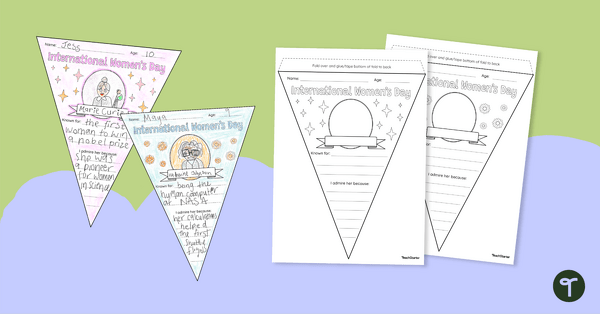
Famous Women in History Pennant - Biography Template
Learn about inspirational women and complete this bunting-style template to display in the classroom for International Women’s Day.
- Plus Plan

What was Women's Suffrage? Digital Interactive Notebook Activity
Learn about life and society during the women’s suffrage movement with a Google Slides interactive notebook.
- Plus Plan

Sojourner Truth Worksheet Pack
Learn about the life and contributions of Sojourner Truth with a comprehensive pack of Women’s History Month worksheets.
- Plus Plan

Sojourner Truth - Printable Book for Kids
Discover the accomplishments and influence that Sojourner Truth had on America with a printable mini-book.
- Plus Plan

Women's Rights Leaders - InstaFan Biography Project
Demonstrate learning about the most influential female leaders in history with an engaging social media biography template.
- Plus Plan
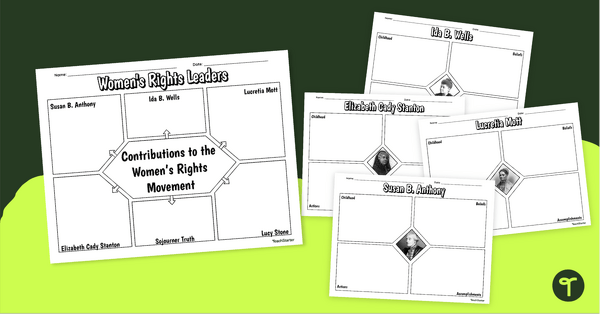
Women's Rights Leaders Graphic Organizer
Organize learning about famous historical figures of the Women’s Rights Movement with a pack of note-taking worksheets.
- Plus Plan
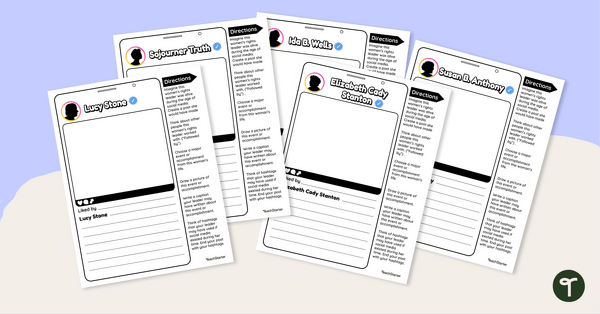
Women's Rights Leaders - InstaFan Post Template
Demonstrate learning about the most influential female leaders during the Women’s Rights movement with an engaging social media template.
- Plus Plan

Leaders of the Women's Suffrage Movement - Instructional Slide Deck
Learn about the most influential female leaders during the Women’s Rights movement with an engaging instructional slide deck.
- Plus Plan

The Women's Suffrage Movement Slide Deck
Provide your students with a look into the women’s suffrage movement with an instructional slide deck.
- Plus Plan

Elizabeth Cady Stanton - Differentiated Comprehension Worksheets
Learn fun facts about Elizabeth Cady Stanton with a differentiated comprehension passage and assessment.
- Plus Plan
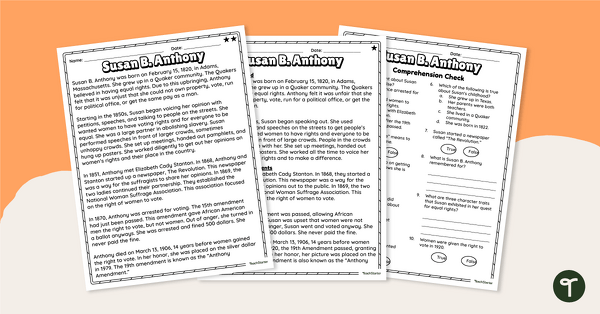
Susan B. Anthony Worksheet Pack - Comprehension
Learn fun facts about Susan B. Anthony with a differentiated Susan B. Anthony Worksheet Pack.
- Plus Plan
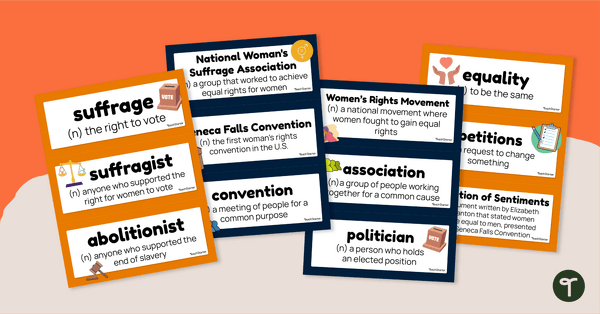
Women's Suffrage Vocabulary Word Wall
Build academic vocabulary surrounding the Women’s Rights Movement with an illustrated vocabulary word wall.
- Plus Plan

Women's Suffrage Flipbook
Learn about the Women’s Rights movement with a Women’s Suffrage Flip Book.
- Plus Plan

Women's Suffrage Vocabulary Graphic Organizers
Review and record key vocabulary surrounding the women's rights movement with a group of customizable vocabulary templates.
- Plus Plan

Abigail Adams Constructed Response Worksheet
Use this passage, writing prompt, and worksheet to help students write a constructed response paragraph about Abigail Adams.
- Plus Plan

Jane Addams Biography - Worksheet
Use this biographical constructed response worksheet to teach your students about Jane Addams.
- Plus Plan

Brilliant, Brave Minds – Comprehension Task
An article and comprehension task celebrating women and Women's History Month.
- Plus Plan

First But Not Last – Comprehension Task
An article about historic women paired with a comprehension task.